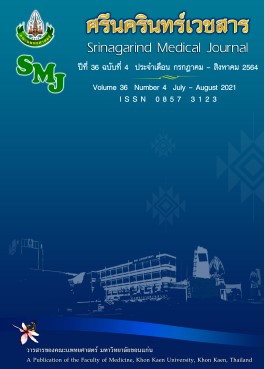ภาวะไขสันหลังบาดเจ็บล่าช้าที่เกิดตามหลังในผู้ป่วยถูกกระแสไฟฟ้าแรงสูงบริเวณศีรษะ ในโรงพยาบาลขอนแก่น: รายงานผู้ป่วย
คำสำคัญ:
ภาวะแทรกซ้อนทางระบบประสาทไขสันหลัง; บาดเจ็บถูกกระแสไฟฟ้าแรงสูง; โรงพยาบาลขอนแก่นบทคัดย่อ
หลักการและวัตถุประสงค์: ภาวะแทรกซ้อนทางระบบประสาทไขสันหลังที่เกิดตามการบาดเจ็บจากกระแสไฟฟ้าแรงสูง ยังมีรายงานและการศึกษาผู้ป่วยลักษณะนี้ในประเทศจำนวนน้อย ทั้งนี้การบาดเจ็บจากกระแสไฟฟ้าแรงสูงนั้นก่อให้เกิดการบาดเจ็บรุนแรงและมีภาวะทุพพลภาพตามมาสูง มีอาการแขนขาอ่อนแรงได้ และส่วนใหญ่หากเริ่มแสดงอาการช้า จากวันที่ได้รับบาดเจ็บ โอกาสที่ผู้ป่วยจะหายเป็นปกติจะลดน้อยลง ผู้วิจัยจึงต้องการที่จะทำการวิจัยและติดตามอาการแสดงดังกล่าว เพื่อเป็นแนวทางในการดูแลรักษาผู้ป่วยลักษณะนี้ต่อไป ดังนั้นการศึกษานี้จึงมีวัตถุประสงค์เพื่อศึกษาลักษณะอาการแสดง การดำเนินของพยาธิสภาพ ของการบาดเจ็บทางระบบประสาทไขสันหลังที่เกิดแบบล่าช้า ตามหลังจากการได้รับอุบัติเหตุถูกกระแสไฟฟ้าเข้าที่บริเวณศีรษะ
วิธีการศึกษา: เป็นการศึกษาวิจัยแบบลักษณะ รายงานผู้ป่วย (Case report study)โดยนำข้อมูลจากเวชระเบียนผู้ป่วยในระบบฐานข้อมูลคอมพิวเตอร์ในหอผู้ป่วยไฟไหม้น้ำร้อนลวก โรงพยาบาลขอนแก่น
ผลการศึกษา: ผู้ป่วยชายอายุ 18 ปี บาดเจ็บจากถูกกระแสไฟฟ้าแรงสูงเข้าที่ศีรษะ หมดสติ ณ ที่เกิดเหตุ มีแผลไหม้ที่บริเวณศีรษะ ไหล่ซ้าย แขนซ้าย และเท้าทั้งสองข้าง แรกรับหลังจากรู้สติ ทำตามสั่ง ไม่มีอาการแขนขาอ่อนแรง ผู้ป่วยเริ่มมีอาการขาสองข้างอ่อนแรง ยกไม่ขึ้น ในวันที่ 7 ให้หลังจากการบาดเจ็บ เริ่มมีแขนอ่อนแรงตามมา ส่งตรวจเพิ่มเติม CT scan และ MRI spine ไม่มีพยาธิสภาพที่อธิบายอาการอ่อนแรงดังกล่าว ผู้ป่วยได้รับการรักษาเรื่องแผลไหม้ตามร่างกายด้วยการผ่าตัดและปิดแผล และให้การดูแลเรื่องกายภาพแขนและขาทุกวันอย่างต่อเนื่อง นอนรักษาตัวในโรงพยาบาล 64 วัน และออกจากโรงพยาบาล เพื่อทำกายภาพต่อเนื่องที่โรงพยาบาลใกล้บ้าน ติดตามอาการที่เวลา 8 เดือนหลังออกจากโรงพยาบาล อาการอ่อนแรงของแขนเป็นปกติ อาการอ่อนแรงของขาดีขึ้น ยืนได้แบบค้ำยัน แต่ยังไม่สามารถเดินได้เป็นปกติ
สรุป: ภาวะแทรกซ้อนทางระบบประสาทไขสันหลังภายหลังการได้รับบาดเจ็บถูกกระแสไฟฟ้าแรงสูง สามารถแสดงอาการได้ทั้งในลักษณะฉับพลันทันที และอาจเกิดตามหลังแบบล่าช้าการรักษาภาวะดังกล่าวยังไม่มีแนวทางหรือข้อบ่งชี้ในการรักษาด้วยยาที่แน่ชัด ส่วนใหญ่เป็นการรักษาตามอาการและประคับประคองอาการ ร่วมกับการกายภาพอย่างถูกต้องและสม่ำเสมอ
เอกสารอ้างอิง
2. Ko SH, Chun W, Kim HC, Delayed spinal cord injury following electrical burns: a 7-year experience. Burn 2004; 30: 691-695.
3. Grube BJ, Heimbach DM, Engraw LH, Copass MK. Neurologic consequences of electrical burns. J Trauma 1990; 30: 254-258.
4. AlQasas T, Galet C, Wibbenmeyer L. Delayed spinal cord injury from electrical burns: Two cases. J Burn Care Res 2021; 42(3): 560-563.
5. Levine NS, Atkins A, McKeel DW Jr, Peck SD, Pruitt BA Jr. Spinal cord injury following electrical accidents: case report. J Trauma 1975; 15: 459-463.
6. Sharma SR, Hussain M, Hibong H. Cervical Myelopathy after high-voltage electrical burn of the head: report of an unusual case. Annals of Indian Academy of Neurology:vol21 2018
7. Silversides J. The neurological sequelae of electrical injury. Can Med Assoc J 1964; 91: 195–204.
8. Varghese G, Mani MM, Redford JB. Spinal cord injuries following electrical accidents. Paraplegia 1986; 24: 159–166.
9. Arévalo JM, Lorente JA, Balseiro‑Gómez J. Spinal cord injury after electrical trauma treated in a burn unit. Burns 1999; 25: 449‑452.
10. Johansen CK, Welker KM, Lindell EP, Petty GW. Cerebral corticospinal tract injury resulting from high‑voltage electrical shock. AJNR Am J Neuroradiol 2008; 29: 1142‑1143.




